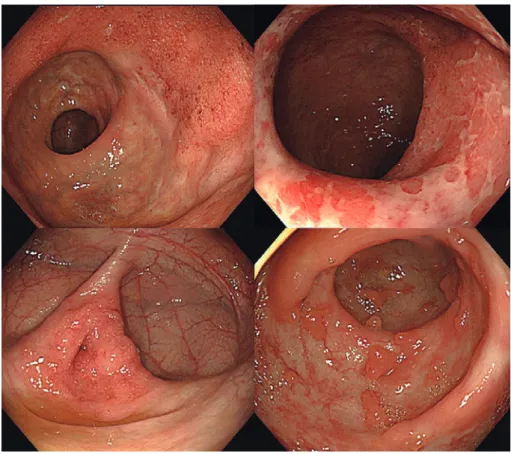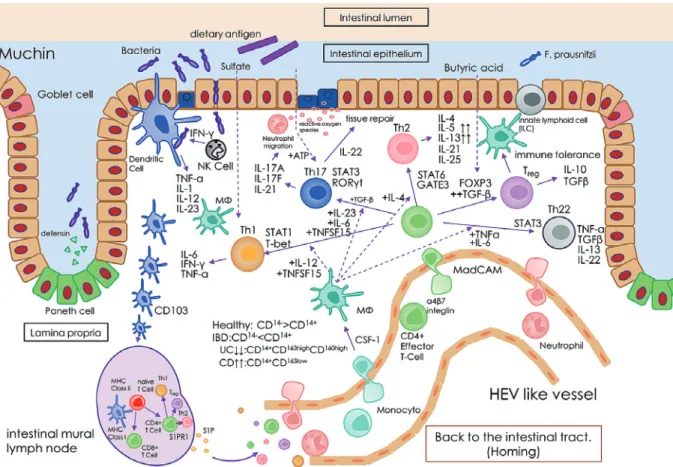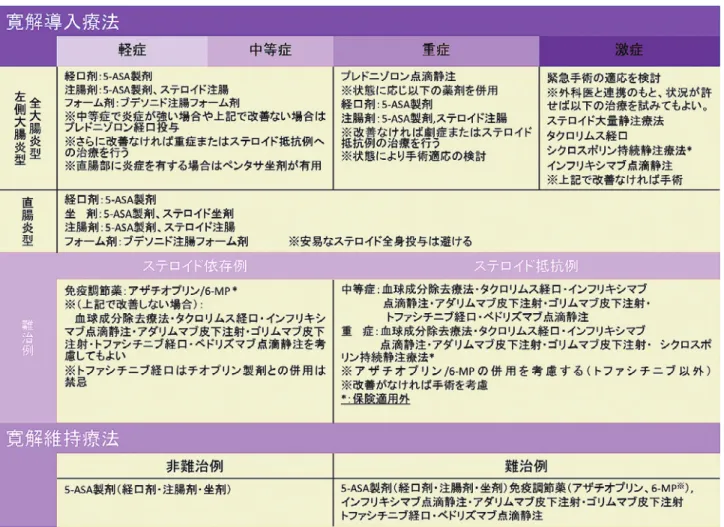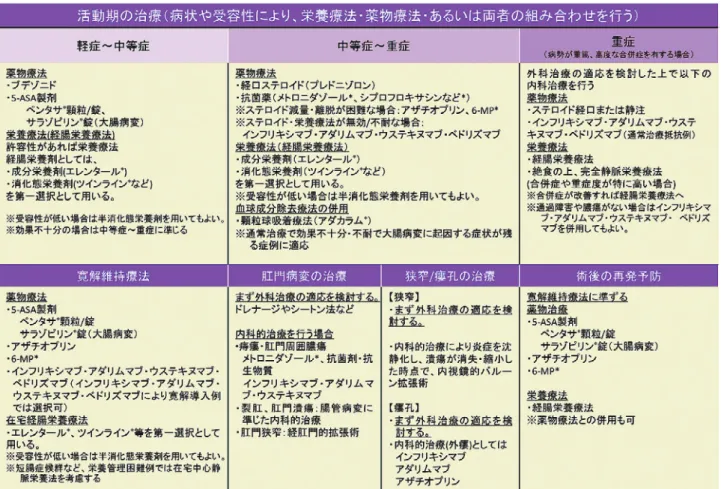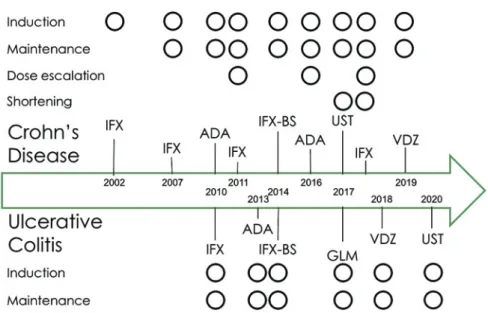総 説 東女医大誌 90(5): 105-116, 2020.10
炎症性疾患
(5)治療と薬剤―消化器系
炎症性腸疾患における内科治療―Up to Date―
東京女子医科大学消化器内科 オオモリ テッペイ大森 鉄平
(受理 2020 年 9 月 2 日) Inflammatory Disease(5) The Medical Treatment of Inflammatory Bowel Disease―Up to Date―
Teppei Omori
Institute of Gastroenterology, Tokyo Women s Medical University, Tokyo, Japan
Inflammatory bowel disease (IBD) is defined as ulcerative colitis (UC) and Crohn s disease (CD). The number of patients with IBD is continuously increasing, with over 200,000 cases of UC and 70,000 cases of CD observed in a 2014 statistical analysis. The mechanisms underlying IBD inflammation remain unclear; however, previous stud-ies have reported that a genetic predisposition to the disease exists. These disease-susceptibility genes, changes in the gut microbiota, and an overreaction to dietary antigens are presumed to cause an uncontrolled immune re-sponse, leading to intestinal inflammation. Therefore, drugs for the treatment of IBD are classical anti-inflammatory agents, and presently, new immunological drugs, that have been developed from the perspective of treating IBD, are used in clinical practice. The Japanese Ministry of Health, Labour and Welfare (MHLW) have developed guidelines for the treatment of IBD in Japan. Appropriate treatment for IBD may vary depending on the activity, extent of inflammation, and presence of complications. In this article, we will discuss the basic con-cepts of UC and CD as well as up-to-date information on medical treatment strategies in Japan.
Key Words: inflammatory bowel disease, TNF antibody agent, IL-12/23p40 antibody agent, anti-integline agent, JAK inhibitor
緒
言
炎 症 性 腸 疾 患(inflammatory bowel disease:
IBD)とは広義には炎症を伴う腸管障害となる感染
性腸炎なども含まれるが,狭義には潰瘍性大腸炎
(ulcerative colitis:UC)とクローン病(Crohn s
dis-ease:CD)を代表とする発症と増悪に免疫機序が関
与している疾患である(Figure 1).IBD の炎症の根
本にあるメカニズムはまだ完全には解明されていな
いものの,樹状細胞やマクロファージ,T 細胞など
の自然免疫および獲得免疫系の過剰発現が生じ
tu-Corresponding Author: 大森鉄平 〒162―8666 東京都新宿区河田町 8―1 東京女子医科大学消化器内科 Email: omori.teppei@twmu.ac.jp doi: 10.24488/jtwmu.90.5_105Copyright Ⓒ 2020 Society of Tokyo Women s Medical University. This is an open access article distributed under the terms of Creative Commons Attribution License (CC BY), which permits unrestricted use, distribution, and reproduction in any medium, provided the original source is properly credited.
Figure 1 Definition of IBD.
Broadly, IBD refers to all diseases which cause inflammation of the intestines, but in par-ticular, UC and CD.
IBD, inflammatory bowel disease; UC, ulcerative colitis; CD, crohn s disease.
mor necrosis factor(TNF)
α を代表とする炎症性サ
イトカインがその病態に関与していることが明らか
になってきている.このため,IBD の治療薬は古典
的な抗炎症作用を有する薬剤を基本とし,現在は免
疫学的な観点から新規薬剤が開発され,実臨床に用
いられてきている.
本稿では,UC と CD における基本的な概念と,本
邦の内科治療の up to date を報告する.
疾患概念
1.臨床的特徴と診断のアウトライン
UC とは主として大腸粘膜を侵し,しばしばびら
んや潰瘍を形成する原因不明のびまん性非特異性炎
症疾患と定義される,厚生労働省が定める指定難病
の一つである
1).症状として持続性または反復性の粘
血便・血性下痢などを生じ,直腸からの連続性・び
まん性・全周性の炎症像を呈することが特徴である
(Figure 2).本邦においては 2014 年の推定患者数は
219,685 人[95% 信頼区間 183,968-255,403 人]で あ
り,現在世界で 2 番目に患者数がいるとされてい
る
2).本症が疑われるときには,理学的検査や血液検
査を行い,さらに放射線照射歴,抗菌薬服用歴,海
外渡航歴などを聴取する.次に大腸内視鏡検査や生
検を行い,本症に特徴的な腸病変を確認することで
診断する.病型としては主に直腸炎型,左側大腸炎
型(直腸から大腸脾湾曲までの範囲),全大腸炎型
(大腸脾湾曲部より口側まで炎症の範囲が進展して
いる)に分けられ,Mayo score や Lichtiger Clinical
Activity Index などの臨床的活動度,内視鏡的重症
度に応じて治療ストラテジーを検討する.
一方で CD は UC と同様に,免疫異常などの関与
が考えられる肉芽腫性炎症性疾患である
1).2014 年
の 推 定 患 者 数 は 70,700 人[95% 信 頼 区 間
56,702-84,699 人]であり,UC 同様にこの 20 年で大幅に増
加している
2).主として若年者に発症し,小腸・大腸
を中心に浮腫や潰瘍を認め,腸管狭窄や瘻孔など特
徴的な病態が口腔から肛門までの消化管のあらゆる
部位に生じる(Figure 3).病変範囲によって症状は
多彩となるが,多くは下痢や腹痛などの消化器症状
と発熱や体重減少・栄養障害などの全身症状を認め
る.さらに貧血,関節炎,虹彩炎,皮膚病変などの
合併症も呈する.病状・病変は再発・再燃を繰り返
しながら進行し,高度な狭窄や瘻孔,膿瘍といった
腸管合併症の形成により腸管切除の適応となること
が多い.術後も吻合部を中心に再発傾向を示し,再
手術の適応となることもある.
UC と同様に抗菌薬服用歴,海外渡航歴などを含
めた十分な問診と理学的検査や血液検査を行う.そ
の上で約 70% の症例が病変を有する回腸末端を含
めた全大腸内視鏡検査やより深部の小腸をターゲッ
トとしたバルーン小腸内視鏡検査,小腸・大腸 X
線造影,上部消化管内視鏡検査により特徴的な腸病
変 を 確 認 す る.ま た magnetic resonance imaging
Figure 2 Endoscopic findings of UC.
The typical endoscopic findings of UC are diffuse, continuous, and generalized inflamma-tory images. Inflammation extends continuously from the rectum to the mouth side, and a border of inflamed mucosa can be observed. Moreover, diffuse inflammation is observed in the mucosa surrounding the ulcer (intervening mucosa). Inflammatory polyps, which are remnants of inflammation, may be found in the healing mucosa. A lesion at the appendiceal orifice is a suspicious finding for UC, even if a rectal lesion is mild and difficult to detect. UC, ulcerative colitis.
Figure 3 Endoscopic findings and effective treatment for CD.
Case of a man with CD in his 20s. Infliximab was introduced early during diagnosis and mucosal healing was achieved after 6 months. Left: longitudinal ulceration in the ileum. Right: mucosal healing was achieved.
(MRI)や computed tomography(CT)所見,小腸
カプセル内視鏡検査所見も診断補助に有用である.
病型(小腸型,小腸大腸型,大腸型)および肛門病
変,上部消化管病変の有無,蓄積された腸管ダメー
ジ(炎症型,狭窄型,瘻孔型),臨床的活動度(多く
は Crohn s Disease Activity Index:CDAI を 用 い
る)に加えて予後不良因子(広範な小腸病変,重篤
な上部消化管病変,肛門病変,複雑痔瘻,発症早期
の狭窄や瘻孔形成,大腸の深い潰瘍性病変)などを
評価する.近年は治療目標に合わせた治療ストラテ
ジーを組み立て,臨床症状および血液検査や画像検
査で評価し治療の適正化を図る.
2.炎症性疾患としての IBD
UC や CD はその発症機序として,遺伝的素因を
有 す る こ と が 以 前 よ り 指 摘 さ れ て お り,近 年 の
Genome Wide Asscociation Study(GWAS)解析に
よって多くの疾患感受性遺伝子が報告されている
3).
UC では human leukocyte antigen(HLA),CD では
欧
米
で
は nucleotide-binding oligomerization
domain-containing protein 2(NOD2)
4),日本人を含
むアジア人種においては TNF superfamily member
15(TNFSF15)などが注目され
5),また両疾患におい
て interleukin(IL)-23R,IL-12B,signal transclucer
and activator of transcription 3(STAT3),Janus
kinase 2(JAK2)などの共通する疾患感受性遺伝子
も多く存在する.これらは後述する薬剤の創薬にも
大きく関わっている.これらの疾患感受性遺伝子を
有する背景に,腸内細菌叢の変化や食 抗原に対す
る過剰反応が本来の生体防御機構である免疫応答を
暴走させ腸管炎症を引き起こしている疾患と考えら
れている.以前 UC はヘルパー T(Th)細胞のうち
Th2 細胞優位,CD は Th1 細胞優位に炎症のカス
ケードに関与していると指摘されていた.しかし現
在は Th17 細胞がそのカスケードにおいて大きな役
割を担っていることが明らかとなり
6),UC は Th2
細胞と Th17 細胞,CD は Th1 細胞と Th17 細胞と
いった炎症性 T 細胞と炎症を抑制する働きを有す
る制御性 T 細胞(regulatory T cell:Treg)の不均衡
がマクロファージと相まって interferon(IFN)γ
や TNFα といった炎症性サイトカインの過剰発現
を生じていることが指摘されている(Figure 4).
IBD の治療薬
1.本邦における治療ガイドライン
日本における IBD の治療指針は厚生労働省難治
性炎症性腸管障害調査研究班によって策定されてお
り,年次的に改訂されている
1).UC,CD ともに病型,
重症度,合併症により推奨される治療が異なる.ま
た IBD 自体が若年者から発症する疾患であり,小児
や妊産婦などの患者背景にも留意が必要である.さ
らに近年では IBD 患者自体の高齢化や高齢発症の
IBD 患者の増加が注目され,治療指針 supplement
として高齢者潰瘍性大腸炎編が発刊されている
7).
IBD に対する治療は活動性炎症がある時に,その炎
症を沈静化する(寛解導入)フェーズと,寛解導入
後に再び炎症が起こらないようにする(寛解維持)
フェーズで考えなければならない.本項では,IBD
に用いられる薬剤の特徴に触れ,保険適応となって
いる疾患を付記するが,各疾患の様々な状態に対す
る治療指針はそれらを参照されたい(Table 1,2)
1).
2.本邦における IBD の治療薬
1)5-アミノサリチル酸(5-ASA)製剤(UC,CD)
5-ASA 製剤の有効成分はメサラジンであり,病変
部である炎症を生じている粘膜に直接作用して活性
酸素抑制,アラキドン酸カスケード阻害,ペルオキ
シソーム増殖因子活性化受容体の活性化
8)∼10),aryl-hydrocarbon receptor 経路を介して大腸粘膜内の
Treg 細胞の誘導にも関与し抗炎症作用を示す
11).し
かしメサラジンは経口内服後,空腸から吸収が始ま
りほとんどが吸収され失活してしまうため,より多
くのメサラジンが大腸粘膜に到達するような drug
delivery system(DDS)を有する 5-ASA 製剤が開発
され,さらに経口剤・注腸・坐剤などの形状で用い
られている.
UC においては,5ASA 製剤は軽症から中等症の
寛解導入療法,ならびに難治例を含むすべての寛解
維持療法として使用することが推奨されている
1).一
方で CD においてはメタ解析の結果から 5ASA 製
剤の有用性は限定的であり
12),欧米のガイドライン
においても,5ASA を積極的に推奨するような記載
はない
13).
2)コルチコステロイド(corticosteroid:CS)・ブ
デソニド(budesonide:BDZ)
(UC,CD)
CS は,グルココルチコイド受容体(GR)に結合し
IL 転写の抑制,転写因子核因子
κB(NF-κB)複合体
を安定化する IκB の誘導,アラキドン酸代謝の抑制
などの炎症経路の阻害を介して作用する(Figure
5)
14).CS は IBD の中等度∼重症の炎症コントロー
ルに最適な薬物である.一方で,感染症や骨粗鬆症
などの CS 特有の副作用のリスクを考慮し長期使用
は避けるべきである.また IBD において,CS の寛解
Figure 4 Inflammatory cells and cytokine networks in IBD.
Abnormalities in innate and acquired immunity caused by the complex interaction of genetic factors, dietary factors, and intestinal microbiota are crucial to the pathogenesis of IBD. In addition to Th1 and Th2 cells, Th17, Th22, and Treg cells are involved in the pathogenesis of IBD. Several drugs targeting the cytokine network formed by these cells have been developed.
IBD, inflammatory bowel disease; GATA, GATA-binding protein; IL, interleukin; IFN, in-terferon; RORγt, retinoic acid receptor-related orphan receptor-γt; TGFβ,transforming growth factor-β; TNF, tumor necrosis factor; STAT, signal transducer and activator of transcription.
導入効果はあるが,寛解維持効果はないとされる.
これは NF-κB が上皮再生に重要な役割を持ち,CS
の長期使用は腸管上皮再生に影響を及ぼす可能性が
あるためである
15).UC,CD ともに CS により寛解導
入を得ても,約 30% の症例は漸減もしくは CS 離脱
後 3 か月以内に再燃する場合がある
16)17).これをステ
ロイド依存性と定義し,CS の代替となる免疫調整薬
や生物学的製剤の使用を検討する.
近年,本邦でも BDZ が新たなステロイド製剤と
して IBD 治療に用いられるようになった.欧米では
1995 年から用いられており,第 2 世代のステロイド
製剤として位置付けられている.他のステロイド製
剤に比べて,炎症粘膜の細胞に取り込まれやすく
18),
IL-1,IL-6 などの様々な炎症性サイトカインをコン
トロールし,局所の炎症を鎮める.一方で体内に吸
収された成分の約 90% が肝臓のチトクローム P450
で速やかに代謝されるため
19),全身への影響が少な
いと考えられている.UC においては,5ASA 製剤同
様 DDS を考慮した局所製剤が開発されており,近
年保険収載された BDZ フォームは泡(フォーム)状
であり,腸管壁に付着し腸内に留まりやすいことが
特徴である.5ASA 局所製剤が有効でないもしくは
不耐の直腸または S 状結腸に炎症の中心がある病
態に適した治療薬である.CD に対しては BDZ 腸溶
性顆粒充填カプセルが保険収載されている.薬効成
分は回腸から上行結腸を中心に放出されるため,回
盲部に主な病変がある軽症∼中等症例に対する第一
選択となっている.BDZ は CS と同様に,寛解導入
効果は期待できるが,寛解維持を目的としての使用
は推奨されない.
Table 1 Guidelines for the treatment of UC in Japan. (Adapted from reference 1)
Treatment guidelines for ulcerative colitis suggest treatment options based on the extent and degree of inflammation. Furthermore, depending on the presence or absence of steroid dependence or resistance, biologics have been proposed as a treatment option for induction and maintenance.
UC, ulcerative colitis.
3)チオプリン:アザチオプリン(Azathioprine:
AZA),6-メルカプトプリン(6-Mercaptopurine:6-MP)
※(UC,CD)※6-MP は保険適応外
チオプリン製剤である AZA は,6MP のプロド
ラッグであり,吸収後に 6-MP となったのち活性代
謝体である 6-thioguanine nucleotides(6TGN)とな
る.6TGN はプリン拮抗薬として DNA の合成を阻
害し,免疫担当細胞の増殖を抑制することで抗炎症
作用を示す(Figure 5).ステロイド依存性 IBD の臨
床的および内視鏡的寛解を達成する上で,5-ASA
製剤よりも効果的である
20).一方,UC においてチオ
プリン製剤の寛解導入効果は乏しい.また後述する
生物学的製剤(特に抗 TNFα 抗体製剤である
Inflixi-mab)の免疫原性に伴う二次無効を回避する目的で
併用することが推奨される.AZA や 6-MP の副作用
として,白血球減少,胃腸症状,膵炎,肝障害,脱
毛などが起こり得るが,重度の急性白血球減少と全
脱毛は 6TGN の代謝酵素である nudix hydrolase 15
(NUDT15)の酵素活性が極めて低くなる codon139
における遺伝子多型の存在と関連することが明らか
となった
21).本邦では 2019 年 2 月より NUDT15 遺
伝子多型検査が保険承認となっており,初めてチオ
プリン製剤の投与を考慮する患者に対しては,チオ
プリン製剤による治療を開始する前に本検査を施行
し,NUDT15 遺伝子型を確認の上でチオプリン製剤
の適応を判断することが推奨される.日本人の約
1% に存在する Cys/Cys 型のリスクホモの場合は,
重篤な副作用のリスクが非常に高くチオプリン製剤
使用自体を回避することが望ましい.Arg/Cys,
Cys/His 型の場合は低用量からの開始を考慮する.
しかし副作用のリスクが低い Arg/Arg,Arg/His
型の場合であっても,NUDT15 遺伝子多型に起因し
ない肝障害や胃腸症状などの副作用も存在するた
め,導入時期は定期的なモニタリングが望ましい
1)Table 2 Guidelines for the treatment of CD in Japan. (Adapted from reference 1)
Treatment guidelines for Crohn s disease suggest treatment options that take into account not only the activity, but also the pres-ence of complications such as anal lesions and stenosis.
CD, crohn s disease.
(Table 3).
4)カ ル シ ニ ュ ー リ ン 阻 害 剤:タ ク ロ リ ム ス
(Tacrolimus:TAC),シクロスポリン(Cyclospolin
A:CyA)
※(UC)※保険適応外
CyA は T リンパ細胞内の cyclophilin A と,TAC
は FK506-binding protein12(FKBP12)と複合体を
形成する.そして Ca
2+・カルモジュリンによって活
性化されたカルシニューリンに結合することで
nu-clear factor of activated T-Cells(NF-AT)の核移行
を抑制し IL-2,IFNγ,TNFα などのサイトカインの
産生を抑制する薬剤である(Figure 5)
22).重症から
激症の UC に対して強力な治療効果を得るが,その
効果は血中濃度に依存しており TAC の場合,寛解
導入期は 10∼15 ng/mL の高トラフを目指し,以後
は 5∼10 ng/mL の 低 ト ラ フ で 維 持 す る.CyA・
TAC ともに長期使用により不可逆的な腎障害を生
じるリスクもあるため,原則として寛解導入後は 3
か月を目安に AZA あるいは 6-MP による維持療法
へ移行する
1).
5)顆粒球吸着除去療法(granulocyte and
mono-cyte adsorption aphersis:GMA)
(UC,CD)
体外循環のカラムを通過させ活性化顆粒球と単球
を選択的に除去する療法である
23).血球成分を除去
するのみでなく,免疫調整作用と抗炎症作用を有す
る myeloid-derived suppressor cell を分化誘導し,
炎症反応を抑制する
24).通常週 1 回計 5 回を 1 クー
ル,連続 2 クール(劇症型は計 11 回まで可)として
行うが,週 2 回など intensive に行うことで,より早
く効果が得られることがある.
6)抗 TNFα 抗 体 製 剤(Infliximab:IFX,
Adalimumab:ADA,Golimumab:GLM)
(UC,CD)
(GLM は UC のみ)
TNFα は Th1 やマクロファージなどから膜貫通
型タンパク質として産生され,可溶性 TNFα はメタ
ロ プ ロ テ イ ナ ー ゼ TNF 変 換 酵 素(TACE;
ADAM17)を介したタンパク質分解により放出され
る.IBD 患者の CD14+マクロファージ,アディポサ
イト,線維芽細胞および T 細胞は,多量の TNFα
Figure 5 Small molecule drugs for IBD.
Small-molecule drugs used for the treatment of IBD in-clude classic steroids and immunomodulators such as cyclosporine, tacrolimus, and azathioprine. Recently, JAK inhibitors, which inhibit JAK-STAT signaling, have also been used for UC.
IBD, inflammatory bowel disease; JAK, Janus kinase; STAT, signal transducer and activator of transcription; UC, ulcerative colitis.
Table 3 Susceptibility to thiopurine associated with the NUDT15 genotype.
Genotype of codon 139
Frequency in Japanese population
Risk of side effects when starting at a normal dose
Starting amount considered safe Acute severe leukopenia Whole hair loss
Arg/Arg 81.1% Extremely rare (<0.1%) Extremely rare (<0.1%) AZA 50 mg/day 6-MP 30 mg/day Arg/His
Arg/Cys 17.8% Low (<5%) Low (<5%) AZA 25 mg/day
6-MP 10-15 mg/day
Cys/His <0.05% High (>50%) High (<5%) 6-MP 5-10 mg/day
Cys/Cys 1.1% Inevitable occurrence Inevitable occurrence Prohibited For patients being considered for thiopurine therapy, it is recommended that this test be performed prior to initiating treatment with thiopurines to confirm the NUDT15 genotype and determine the indication for thiopurines.
Arg, arginine; AZA, azathioprine; Cys, cysteine; His, histidine; NUDT15, nudix hydrolase15; 6-MP, 6-mercaptopurine.
を産生する
25)∼27).TNFα は,受容体である TNFFR
1 および TNFFR2 に結合した後,NFκB を細胞内で
活性化させることにより,内皮細胞の活性化,好中
球の活性化など様々な炎症促進機能を発揮すると考
えられている.特に膜結合型 TNF が腸内炎症の促
進に大きな役割を果たしていることが明らかとなっ
た
28).
抗 TNFα 抗体製剤は,適正なステロイド使用にも
かかわらず,効果が不十分な場合(ステロイド抵抗
例)と,ステロイド投与中は安定しているがステロ
イドの減量に伴い再燃増悪する場合(ステロイド依
存例)等より選択される.劇症型を含む重症例では
IFX 点滴静注が考慮される.IFX は初回 5 mg/kg
の点滴静注を行い,2 週間後・6 週間後,以後維持療
法として 8 週間ごとに点滴静注を行う.維持療法期
における CD の効果減弱例では 10 mg/kg の倍量投
与もしくは 4 週間ごとの期間短縮投与ができる.
ADA は初回 160 mg の皮下注射を行い,2 週間後に
80 mg の皮下注射を行う.その後は 40 mg の皮下注
射を 2 週間ごとに寛解維持療法として行う.維持療
法期における CD の効果減弱例では 80 mg の倍量
投与ができる.GLM は初回 200 mg の皮下注射を行
い,2 週間後に 100 mg の皮下注射を行う.その後は
100 mg の皮下注射を 4 週間ごとに寛解維持療法と
して行う.ADA と GLM は条件が満たされれば,自
己注射も可能である.
抗 TNFα 抗体製剤,特に IFX の臨床上の課題と
して免疫原性に伴う二次無効が存在する.IFX に関
しては前述したように AZA の併用を行うことで二
次無効に伴う効果減弱の回避を図る.GLM はトラン
スジェニック法で作成された完全ヒト型 IgG1 モノ
クローナル抗体であり,理論的には既存の抗体製剤
よりも免疫原性が低いと考えられている
29).
7)JAK 阻害剤(Tofacitinib:TOF)
(UC)
JAK-STAT 系はサイトカインなどの細胞外シグ
ナルを細胞核に伝え,必要な遺伝子の発現を誘導す
る
30).JAK は JAK1,JAK2,JAK3,tyrosine kinase
(TYK2)の 4 種類の異なる分子で構成され,STAT
との組み合わせによって,特異的にサイトカインシ
グナルが決定される(Table 4)
31)∼33).TOF は JAK
1,JAK2,JAK3 を阻害する低分子経口薬であり,特
に JAK1 と JAK3 を優先的に阻害することで,複数
のサイトカインの作用をブロックすることで有効性
Table 4 Major Cytokines Involved
in Inflammatory Bowel Disease and JAK complex against cytokines in-volved in the JAK Pathway.
Cytokine JAK complex
IL-2 JAK1/3 IL-7 JAK1/3 IL-15 JAK1/3 IL-21 JAK1/3 IL-6 JAK1/2/TYK2 IL-13 JAK1/2/TYK2 IFN-γ JAK1/2 IL-22 JAK1/TYK2 IL-12 JAK2/TYK2 IL-23 JAK2/TYK2 IL-5 JAK2/2 IL-1β − IL-8 − IL-17 − IL-18 − TNF-α −
JAK is composed of four different molecules, JAK1, JAK2, JAK3, and tyrosine kinase (TYK2), whose cy-tokine signaling is specifically de-termined by the combination with STAT.
IL, interleukin; IFN, interferon; JAK, Janus kinase; TYK2, tyrosine kinase2.
を発揮する
34).さらに低分子化合物のため生物学的
製剤で懸念される免疫原性もない利点がある.一方
で TOF の安全性には留意すべき点があり,特にア
ジア人種において帯状疱疹のリスクがあり
35),近年
では血栓性イベントの用量依存性の増加が報告され
ている
36).TOF 投与時にはチオプリン製剤の併用は
原則禁忌である
1).
8)IL12/23p40 抗体(Ustekinumab:UST)
(UC,
CD)
ヘテロ二量体サイトカインである IL 12 ファミ
リー(IL 12,IL 23,IL 27 および IL 35 など)は,樹状
細胞やマクロファージなどの抗原提示細胞によって
産生される.IL-12,IL-23 はそれぞれ p35 と p40,p19
と p40 のサブユニットから構成される
37).T リンパ
球の分化において IL-12 は Th1 細胞への分化を,ま
た IL-23 は Th17 細胞への誘導を促進する.Th1 細
胞からは IFNγ や TNFα の産生,Th17 細胞からは
IL-22 や IL-17 の産生が誘導され,IL-22 は粘膜上皮
の再生に関わるが,IL-17 は炎症を惹起し,局所的な
Th17 の応答を永続化させ Treg 活性を抑制する
38).
このため IL12/23 は IBD の炎症機序において重要
なファクターであると考えられている.
UST は IL-12 と IL-23 に共通する p40 サブユニッ
トに対する抗体であり,CD と UC における有効性
が示された
39)40).UST はトランスジェニック法を用
いて作成された完全ヒト型 IgG1 モノクローナル抗
体であり,免疫原性による二次無効リスクを抑えた
製剤である.
9)イ ン テ グ リ ン 阻 害 剤(Vedolizumab:VDZ)
(UC,CD)
IBD における腸管局所の炎症の進展には活性化
した T リンパ球の遊走・ホーミングが関わってい
る.T リンパ球は腸管組織が所属する二次リンパ系
器官で樹状細胞により抗原提示を受ける.レチノイ
ン酸の存在下において核内受容体であるレチノイン
酸受容体(RAR)を介して T リンパ球に接着因子で
ある
α4β7 インテグリンが発現する
41).T リンパ球上
に発現した接着因子と血管内皮細胞上に発現した接
着因子が結合することで T リンパ球が組織浸潤す
る.この組み合わせは各臓器で異なっており,腸管
への T リンパ球の浸潤には T リンパ球上の
α4β7
インテグリンと高内皮円柱様静脈(HEV like
ves-sels)の 血 管 内 皮 細 胞 上 に 多 く 発 現 し て い る
MAdCAM-1 と結合し特異的にホーミングされる
42).
VDZ は
α4β7 インテグリンに対するヒト化 IgG1 モ
ノクローナル抗体で,T リンパ球の腸管組織への浸
潤を特異的に阻害することで炎症を鎮静化させる.
活性化 T リンパ球の遊走を抑制する細胞接着分
子を標的とした治療は,既存のサイトカインをター
ゲットとした治療と機序が異なり,難治性を有する
症例においても有効性が期待される.現時点では点
滴静注投与であるが,今後皮下注製剤が保険収載さ
れる予定である.
今後の展望
IBD の診断と本邦における IBD の治療薬を概説
した.IBD の根治はまだ困難であるが,免疫学的な
観点から病態の解明が行われつつあり,抗 TNF
α
抗体製剤を皮切りに様々な新規薬剤が開発されてき
た経過がある(Figure 6).現時点においても IL-23
p19
抗体(Risankizumab,Guselkumab,Tildrakizu-mab,Milikizumab,Brazikumab)
43),JAK1 選択的阻
害剤(Filgotinib,Upadacitinib)
44),リンパ球上に発
現する G タンパク質共役型受容体である S1P 受容
体(S1PR)アゴニストの Ozanimod
45)46),インテグリ
ン 阻 害 剤(Etrolizumab,AJM300,PF-00547659 な
Figure 6 Approval of biologics for UC and CD in Japan.
Since the use of infliximab for CD began in 2002, the same TNF inhibitors have mainly been used for this purpose. In recent years, drugs with new mechanisms of action, such as IL12/23p40 antibodies and integrin inhibitors, have been launched. Notably, the available dosing options vary by disease.
CD, crohn s disease; IFX, infliximab; ADA, adalimumab; BS, biosimilar; GLM, golimumab; UC, ulcerative colitis; UST, ustekinumab; VDZ, vedolizumab.
ど)
47)∼49),抗 IL-36R 抗体(spesolimab)
50)など薬剤の臨
床試験が進行している.今後の IBD 治療においての
光明である一方,複雑化した治療体系は臨床上の課
題となる.薬剤作用機序を考慮し,個々の病態に即
したストラテジーを構築することが望まれる.
開示すべき利益相反はない. 文 献 1)厚生労働科学研究費補助金 難治性疾患等政策研 究事業「難治性炎症性炎症腸管障害に関する調査研 究」(鈴木班)令和元年度分担研究報告書.潰瘍性大 腸炎・クローン病診断基準・治療指針.2)Murakami Y, Nishiwaki Y, Oba MS et al: Esti-mated prevalence of ulcerative colitis and Crohn s disease in Japan in 2014: an analysis of a nationwide survey. J Gastroenterol 54: 1070―1077, 2019 3)Rivas MA, Beaudoin M, Gardet A et al: Deep
re-sequencing of GWAS loci identifies independent rare variants associated with inflammatory bowel disease. Nat Genet 43: 1066―1073, 2011
4)Jostins L, Ripke S, Weersma RK et al: Host-microbe interactions have shaped the genetic archi-tecture of inflammatory bowel disease. Nature 491: 119―124, 2012
5)Park SC, Jeen YT: Genetic Studies of Inflamma-tory Bowel Disease-Focusing on Asian Patients. Cells 8: 404, 2019
6)Sharon P, Stenson WF: Enhanced synthesis of leu-kotriene B 4 by colonic mucosa in inflammatory
bowel disease. Gastroenterology 86: 453―460, 1984 7)Higashiyama M, Sugita A, Koganei K et al:
Man-agement of elderly ulcerative colitis in Japan. J Gas-troenterol 54: 571―586, 2019
8)Simmonds NJ, Millar AD, Blake DR et al: Anti-oxidant effects of aminosalicylates and potential new drugs for inflammatory bowel disease: assess-ment in cell-free systems and inflamed human col-orectal biopsies. Aliment Pharmacol Ther 13: 363― 372, 1999
9)Rousseaux C, Lefebvre B, Dubuquoy L et al: In-testinal antiinflammatory effect of 5-aminosalicylic acid is dependent on peroxisome proliferator-activated receptor-gamma. J Exp Med 201: 1205 ― 1215, 2005
10)Schmidt C, Fels T, Baumeister B et al: The effect of 5-aminosalicylate and para-aminosalicylate on the synthesis of prostaglandin E2 and leukotriene B4 in isolated colonic mucosal cells. Curr Med Res Opin 13: 417―425, 1996
11)Oh-Oka K, Kojima Y, Uchida K et al: Induction of colonic regulatory T cells by mesalamine by acti-vating the aryl hydrocarbon receptor. Cell Mol Gas-troenterol Hepatol 4: 135―151, 2017
12)Ford AC, Kane SV, Khan KJ et al: Efficacy of 5-aminosalicylates in Crohn s disease: systematic re-view and meta-analysis. Am J Gastroenterol 106 : 617―629, 2011
13)Gomollón F, Dignass A, Annese V et al: 3rd Euro-pean evidence-based consensus on the diagnosis and management of Crohn s disease 2016: Part 1: di-agnosis and medical management. J Crohns Colitis
11: 3―25, 2017
14)Creed TJ, Probert CSJ: Review article: steroid re-sistance in inflammatory bowel disease-mechanisms and therapeutic strategies. Aliment Pharmacol Ther 25: 111―122, 2007
15)Nenci A, Becker C, Wullaert A et al: Epithelial NEMO links innate immunity to chronic intestinal inflammation. Nature 446: 557―561, 2007
16)Khan N, Abbas A, Williamson A et al: Prevalence of corticosteroids use and disease course after in-itial steroid exposure in ulcerative colitis. Dig Dis Sci 58: 2963―2969, 2013
17)Faubion WA, Loftus EV, Harmsen WS et al: The natural history of corticosteroid therapy for inflam-matory bowel disease : a population-based study. Gastroenterology 121: 255―260, 2001
18)Hochhaus G, Derendorf H, Möllmann HW et al: Pharmacodynamic aspects of glucocorticoid action. InGlucocorticoid Therapy in Chronic Inflammatory Bowel Disease: From Basic Principles to Rational Therapy ( Möllmann HW, May B eds ) , pp 61 ― 79, Springer Netherlands, Germany (1993)
19)Jönsson G, Aström A, Andersson P: Budesonide is metabolized by cytochrome P450 3A (CYP3A) en-zymes in human liver. Drug Metab Dispos 23: 137― 142, 1995
20)Harbord M, Eliakim R, Bettenworth D et al: Third european evidence-based consensus on diag-nosis and management of ulcerative colitis. Part 2: current management. J Crohns Colitis 11: 769―784, 2017
21)Kakuta Y, Naito T, Onodera M et al: NUDT 15 R139C causes thiopurine-induced early severe hair loss and leukopenia in Japanese patients with IBD. Pharmacogenomics J 16: 280―285, 2016
22)Kino T, Hatanaka H, Hashimoto M et al: FK-506, a novel immunosuppressant isolated from a Strep-tomyces. I. Fermentation, isolation, and physico-chemical and biological characteristics. J Antibiot (Tokyo) 40: 1249―1255, 1987
23)Kanekura T, Hiraishi K, Kawahara K et al: Granulocyte and mono-cyte adsorption apheresis (GCAP) for refractory skin diseases caused by acti-vated neutrophils and psoriatic arthritis: evidence that GCAP removes Mac-1-expressing neutrophils. Ther Apher Dial 10: 247―256, 2006
24)Sakanoue M, Higashi Y, Kanekura T: Inhibition of Inflammatory Cytokines and Induction of Myeloid-Derived Suppressor Cells by the Effects of Granulocyte and Monocyte Adsorption Apheresis. Ther Apher Dial 21: 628―634, 2017
25)Strober W, Fuss IJ, Blumberg RS: The immunol-ogy of mucosal models of inflammation. Annu Rev Immunol 20: 495―549, 2002
26)Kamada N, Hisamatsu T, Okamoto S et al: Unique CD14 intestinal macrophages contribute to the pathogenesis of Crohn disease via IL-23/IFN-γ axis. J Clin Invest 118: 2269―2280, 2008
27)Atreya R, Zimmer M, Bartsch B et al: Antibodies against tumor necrosis factor (TNF) induce T-cell apoptosis in patients with inflammatory bowel
dis-eases via TNF receptor 2 and intestinal CD 14 + macrophages. Gastroenterology 141 : 2026 ― 2038, 2011
28)Perrier C, de Hertogh G, Cremer J et al: Neutrali-zation of membrane TNF, but not soluble TNF, is crucial for the treatment of experimental colitis. In-flamm Bowel Dis 19: 246―253, 2013
29)Hutas G: Golimumab, a fully human monoclonal an-tibody against TNFalpha. Curr Opin Mol Ther 10: 393―406, 2008
30)Vijayakrishnan L, Venkataramanan R, Gulati P: Treating Inflammation with the Janus kinase in-hibitor CP-690,550. Trends Pharmacol Sci 32: 25―34, 2011
31)Soendergaard C, Bergenheim FH, Bjerrum JT et
al: Targeting JAK-STAT Signal Transduction in
IBD. Pharmacol Ther 192: 100―111, 2018
32)Danese S, Grisham M, Hodge J et al: JAK inhibi-tion using tofacitinib for inflammatory bowel dis-ease treatment: a hub for multiple inflammatory cy-tokines. Am J Physiol Gastrointest Liver Physiol
310: G155―G162, 2016
33)Hodge JA, Kawabata TT, Krishnaswami S et al: The mechanism of action of tofacitinib-an oral Janus kinase inhibitor for the treatment of rheuma-toid arthritis. Clin Exp Rheumatol 34: 318―328, 2016 34)Adis Editorial: Tofacitinib. Drugs RD 10: 271―284,
2010
35)Winthrop KL, Melmed GY, Vermeire S et al: Her-pes zoster infection in patients with ulcerative coli-tis receiving tofacitinib. Inflamm Bowel Dis 24 : 2258―2265, 2018
36)Sandborn WJ, Panés J, Sands BE et al: Venous thromboembolic events in the tofacitinib ulcerative colitis clinical development programme. Aliment Pharmacol Ther 50: 1068―1076, 2019
37)Croxford AL, Kulig P, Becher B: IL-12-and IL-23 in health and disease. Cytokine Growth Factor Rev
25: 415―421, 2014
38)Neurath MF: Cytokines in inflammatory bowel dis-ease. Nat Rev Immunol 14: 329―342, 2014
39)Feagan BG, Sandborn WJ, Gasink C et al: Ustekinumab as induction and maintenance ther-apy for Crohn s disease. N Engl J Med 375: 1946― 1960, 2016
40)Sands BE, Sandborn WJ, Panaccione R et al: Ustekinumab as induction and maintenance ther-apy for ulcerative colitis. N Engl J Med 381: 1201― 1214, 2019
41)Iwata M, Hirakiyama A, Eshima Y et al: Retinoic acid imprints gut-homing specificity on T cells. Im-munity 21: 527―538, 2004
42)Arihiro S, Ohtani H, Suzuki M et al: Differential expression of mucosal addressin cell adhesion molecule-1 (MAdCAM-1 ) in ulcerative colitis and Crohn s disease. Pathol Int 52: 367―374, 2002 43)Wong U, Cross RK: Expert opinion on
interleukin-12 / 23 and interleukin-23 antagonists as potential therapeutic options for the treatment of inflamma-tory bowel disease. Expert Opin Investig Drugs 28: 473―479, 2019
44)Rogler G: Efficacy of JAK inhibitors in Crohn s dis-ease. J Crohns Colitis 14 : S 746 ― S 754, 2020, doi : 10.1093/ecco-jcc/jjz186
45)Feagan BG, Sandborn WJ, Danese S et al: Ozani-mod induction therapy for patients with Ozani-moderate to severe Crohn s disease : a single-arm, phase 2, prospective observer-blinded endpoint study. Lan-cet Gastroenterol Hepatol 5 : 819 ― 828, 2020, doi : 10.1016/S2468-1253 (20) 30188-6
46)Sandborn WJ, Feagan BG, Wolf DC et al: Ozani-mod induction and maintenance treatment for ul-cerative colitis. N Engl J Med 374: 1754―1762, 2016 47)Sandborn WJ, Vermeire S, Tyrrell H et al:
Etroli-zumab for the treatment of ulcerative colitis and Crohn s disease: an overview of the phase 3 clinical
program. Adv Ther 37: 3417―3431, 2020
48)Fukase H, Kajioka T, Oikawa I et al: AJM300, a novel oral antagonist ofα4-integrin, sustains an in-crease in circulating lymphocytes : A randomised controlled trial in healthy male subjects. Br J Clin Pharmacol 86: 591―600, 2020
49)Vermeire S, Sandborn WJ, Danese S et al: Anti-MAdCAM antibody ( PF-00547659 ) for ulcerative colitis ( TURANDOT ) : a phase 2, randomised, double-blind, placebo-controlled trial. Lancet 390 : 135―144, 2017
50)Leppkes M, Neurath MF: Cytokines in inflamma-tory bowel diseases-Update 2020. Pharmacol Res

